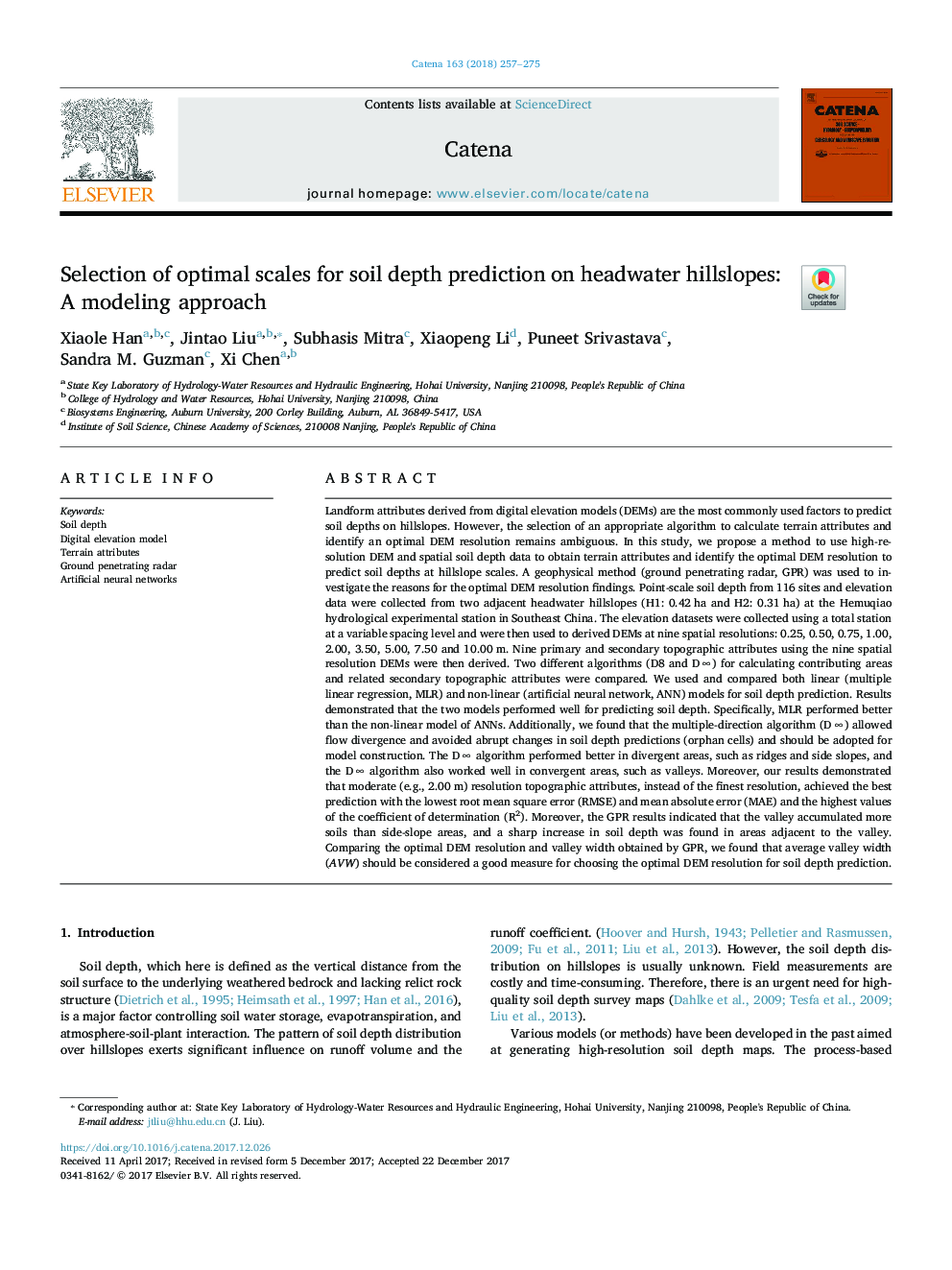| کد مقاله | کد نشریه | سال انتشار | مقاله انگلیسی | نسخه تمام متن |
|---|---|---|---|---|
| 8893697 | 1629191 | 2018 | 19 صفحه PDF | دانلود رایگان |
عنوان انگلیسی مقاله ISI
Selection of optimal scales for soil depth prediction on headwater hillslopes: A modeling approach
ترجمه فارسی عنوان
انتخاب مقیاس مطلوب برای پیش بینی عمق خاک در تپه های رودخانه: یک روش مدل
دانلود مقاله + سفارش ترجمه
دانلود مقاله ISI انگلیسی
رایگان برای ایرانیان
کلمات کلیدی
عمق خاک، مدل ارتفاع دیجیتال، ویژگی های زمین، رادار نفوذی زمینی، شبکه های عصبی مصنوعی،
موضوعات مرتبط
مهندسی و علوم پایه
علوم زمین و سیارات
فرآیندهای سطح زمین
چکیده انگلیسی
Landform attributes derived from digital elevation models (DEMs) are the most commonly used factors to predict soil depths on hillslopes. However, the selection of an appropriate algorithm to calculate terrain attributes and identify an optimal DEM resolution remains ambiguous. In this study, we propose a method to use high-resolution DEM and spatial soil depth data to obtain terrain attributes and identify the optimal DEM resolution to predict soil depths at hillslope scales. A geophysical method (ground penetrating radar, GPR) was used to investigate the reasons for the optimal DEM resolution findings. Point-scale soil depth from 116 sites and elevation data were collected from two adjacent headwater hillslopes (H1: 0.42Â ha and H2: 0.31Â ha) at the Hemuqiao hydrological experimental station in Southeast China. The elevation datasets were collected using a total station at a variable spacing level and were then used to derived DEMs at nine spatial resolutions: 0.25, 0.50, 0.75, 1.00, 2.00, 3.50, 5.00, 7.50 and 10.00Â m. Nine primary and secondary topographic attributes using the nine spatial resolution DEMs were then derived. Two different algorithms (D8 and DÂ â) for calculating contributing areas and related secondary topographic attributes were compared. We used and compared both linear (multiple linear regression, MLR) and non-linear (artificial neural network, ANN) models for soil depth prediction. Results demonstrated that the two models performed well for predicting soil depth. Specifically, MLR performed better than the non-linear model of ANNs. Additionally, we found that the multiple-direction algorithm (DÂ â) allowed flow divergence and avoided abrupt changes in soil depth predictions (orphan cells) and should be adopted for model construction. The DÂ â algorithm performed better in divergent areas, such as ridges and side slopes, and the DÂ â algorithm also worked well in convergent areas, such as valleys. Moreover, our results demonstrated that moderate (e.g., 2.00Â m) resolution topographic attributes, instead of the finest resolution, achieved the best prediction with the lowest root mean square error (RMSE) and mean absolute error (MAE) and the highest values of the coefficient of determination (R2). Moreover, the GPR results indicated that the valley accumulated more soils than side-slope areas, and a sharp increase in soil depth was found in areas adjacent to the valley. Comparing the optimal DEM resolution and valley width obtained by GPR, we found that average valley width (AVW) should be considered a good measure for choosing the optimal DEM resolution for soil depth prediction.
ناشر
Database: Elsevier - ScienceDirect (ساینس دایرکت)
Journal: CATENA - Volume 163, April 2018, Pages 257-275
Journal: CATENA - Volume 163, April 2018, Pages 257-275
نویسندگان
Xiaole Han, Jintao Liu, Subhasis Mitra, Xiaopeng Li, Puneet Srivastava, Sandra M. Guzman, Xi Chen,
